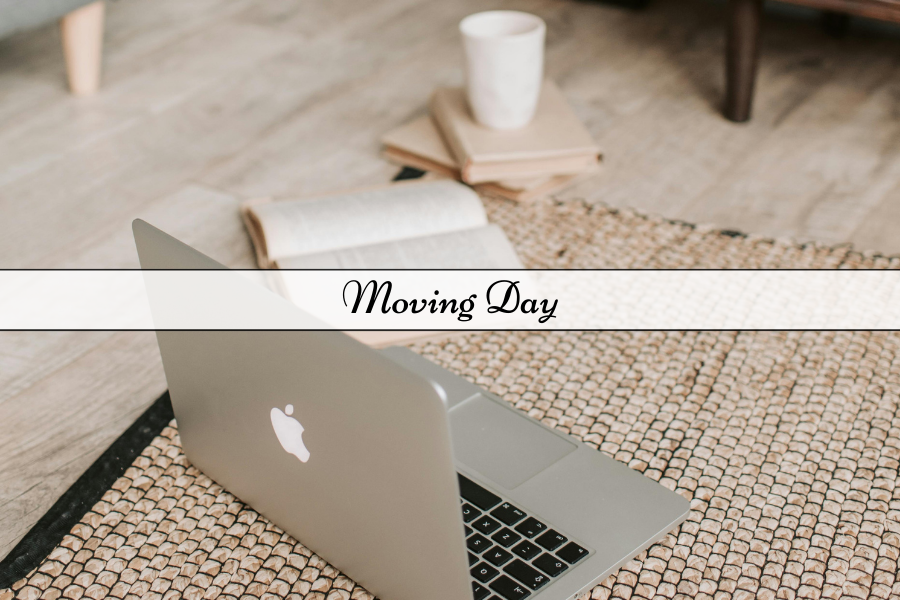Moving day fast approaching? Here is your step-by-step guide for everything you need to do for moving day to run as smoothly as possible.

Moving day can be very chaotic and tiring, so it’s best to know exactly what you need to do ahead of time.
We'll cover everything you need to do in 17 steps and go through:
Preparing for moving day
On Moving Day: In Your Old Home
On Moving Day: In Your New Home
This post is all about moving day.
Preparing For Moving Day
Step 1: Prepare your moving day boxes ahead of time

Usually by moving day everything should be packed up and ready to go with just a few items left unpacked which you will need for the day ahead.
On moving day, there will be a few boxes that you should keep separate from the rest of your items. Prepare these boxes in advance (as much as you can). These boxes include 1.) essential items 2.) key personal items and 3.) moving materials
Moving Day Essential items
- Kettle
- Tea
- Coffee
- Milk
- Sugar
- Biscuits/snacks
- Disposable cups/stirrers/plates/bowls
- Cutlery
- Kitchen roll/napkins
- Disposable gloves
- Carrier bags
- First aid kit
- Water/cold drinks
- Cleaning materials: cleaning cloth and detergent
- Wet wipes
- Towel
- Blanket
- Torches
Personal box
- Medicines
- Glasses/Contact Lenses
- Keys
- Handbag
- Phones/laptops/chargers
- Notebook and pen/diary
- Paperwork for the move (i.e removal contract/invoice/solicitors details/estate agents details)
- Passports/driving licences/ valuables
- Important documents – insurance, birth certificates, identification etc.
- Coat/shoes/gloves/scarves/hats (depending on time of year)
- Bed sheets
- Pyjamas and underwear
- Change of clothes-t-shirt/jeans
- Toiletries- toothbrush/toothpaste/soap
You can pack cases with clothes that you are going to need for the first few days after you move in. This will be easier than trying to rummage through numerous boxes to find what you want to wear.
Moving Day Materials
- Scissors
- Marker
- Labels
- Packing tape
- Screwdriver
- Paper
Transport the personal box yourself to your new home. The essentials box and moving day materials can be put in the removals van last.
Step 2: Make sure everyone has correct information and you have cash ready

- Get the telephone number of the removal team/driver and make sure they have yours. This is important in case they get lost on the day. Confirm the exact location and full address of the new property so that everyone is clear where they are going to
- Arrange someone to change the locks in your new home in advance. Make sure they have the correct address and time to arrive
- Take out some cash and put it in an envelope so you can tip the removals people at the end of the day. Remember tipping is not compulsory, but it will be greatly appreciated!
On Moving Day: In Your Old Home
Step 3: Get up early and EAT on moving day

It's best to have an early start and not to skip breakfast or the coffee. The last thing you want is everyone getting hangry when they're tired and stressed.
Step 4: Wear sensible clothing
Loose fitting and comfortable clothing is a must. Clothes with lots of pockets will also be useful, so you can keep your keys and phone on you.
Wear sensible footwear with a closed toe so that if you drop anything on your foot, you won't be in agony!
Step 5: Introduce the removals men
If you have a professional removals company, the removals men will load the boxes and furniture into the removal van and unload at your new house. They will also deal with any dismantling of furniture and packing up.
How long it takes to load the van will depend on the size of your house. This should be discussed with the removals team ahead of moving day so you know what to expect.
When the removals team arrive, it is best to:
- Introduce everyone and just have a chat about the day ahead and any concerns
- Walk them through the entire house and point out any items that are staying, any items that are particularly fragile or items that need dismantling. The removals team usually carry a full stocked tool box with them
- Place stickers on the appliances or items that are staying behind in the house to ensure the removals men don't take these by mistake
- Show them where the bathroom is and make sure there is enough toilet roll, soap and paper towels
Once the removal men start removing the packed boxes and the furniture, the rooms will start to empty quite quickly. There may not actually be that much for you to do at this point other than wait for the house to be completely emptied.
Step 6: Take pictures and label correctly

Photograph the back of electronics (computers/TV) to see where all the cables go before dismantling, so you'll know where each of the cables go in your new home.
Have a few freezer bags ready to put the cables in and label which appliance/furniture they belong to and keep these in a separate accessible box.
Remember:
- Label all boxes on the top and side of the box
- Use bright coloured labels to make them easy to see
- Colour code the labels by room if you have time
Step 7: Take regular breaks on moving day
The removals men will take regular breaks and will welcome cups of tea and biscuits. This should remind you to take regular breaks too ! Stay hydrated as it's easy to get carried away trying to do too much.
If you're also dealing with kids, pets and elderly relatives, make sure you keep an eye out for them too. You can check out our posts on 15 Top Tips on Moving With Kids and 15 Things You Should Always Do When Moving with Dogs for extra tips.
Step 8: Loading the Van
Remember the last items loaded into the van are the first items out of the van when unloading. Tell the removals team the essential boxes that you will need when you arrive at the house, so they can be kept separate and put in the van last.
Put the floor brush/hoover last into the van too, so you don't have to wait for everything else to be unloaded first.
However, do not give any valuables, such as jewellery or irreplaceable items, to the removals team. Keep these in a safe place and transport them yourself to your new home.
Step 9: Leave your house in good condition

- Turn off any appliances that are being left in the house. Make sure all the taps are turned off. If the house will be empty for a long period of time, you can turn off the water from the main stop valve
- Close any windows and the curtains (if there are any) just in case the house is unoccupied after you move out. You don't want to make it too obvious that the house is empty
- Check nothing has been left behind. Check cupboards, draws, behind doors, under bed etc.
- Take all the rubbish away
- Leave any old paints/tiles that belong to the house, as the new owners may use these
- Leave any mail for the new owners and instruction booklets. You could also write down the day of rubbish collection and other useful pieces of information you think the owners might need
- Label the different keys that you're leaving behind, so the new owners know which key opens the correct door
- Photograph the empty house if you have time just for your memory, and to show the house is empty and left in a tidy state
- Lock up the house if the new owner has not arrived yet so your house is secure
Step 10: Take pictures of meter readings in your house
Take a final picture of your meter readings (i.e. gas, electric and water), as you will need to give these to your utility suppliers for a final bill. You don't want to be overcharged, so make sure you save these photos !
Step 11: Hand over the keys and say goodbye
Once you hear from your lawyer that the funds have arrived, hand over the keys to the new owner, estate agent or whoever has agreed to take the keys.
You may also want to pop into your neighbours to say your goodbyes.
On Moving Day: In Your New Home

Step 12: Arrive at your new property and take the keys
Once you arrive at your new property, the owners or estate agent will give you the keys to your new home.
Step 13: Check the property and take a picture of the meter readings in your new home
Hopefully, the property has been left as you expected it. Walk through with everyone, including the removals team. Identify any potential issues with manoeuvring furniture in and out of rooms.
Take pictures of the meter readings in your new home and check that the water, electricity/lights, and gas are all working. You will need to submit the meter readings online to your new utility suppliers in the coming days, but take a picture just in case there are any disputes.
Check the property is also secure (i.e. windows, external doors locked).
Step 14: Label rooms for the removals team
The removal men will usually just place the boxes and furniture in the relevant room, and re-assemble any items they have dismantled. They won't unpack any of the boxes unless this has been agreed beforehand.
Put large labels/pieces of paper on each room, so the removals team can place the boxes in the correct room.
Guide the removals team when placing furniture down, as you want to make sure you get them in the right place. This way you avoid having to move it yourself later (which you may find difficult to do!).
Step 15: Change the Locks
At the first opportunity, change the locks on your new property so you can feel safe and secure in your new home. It is a good idea to arrange a locksmith in advance to come on moving day.
Step 16: Prioritise dinner
The removals team will leave once all the boxes and furniture have been unloaded. It is easy to feel overwhelmed and emotional with the chaos around you. However, don't force yourself to do too much.
If you stay up late to unpack as many boxes as you can, you will be less productive the next day and feel even more overwhelmed.
Accept there will be some chaos for a while and that is ok. Just do a little bit each day and you will soon see progress.
Have a takeaway (get Deliveroo !) or a prepared meal and sit down for dinner.
Step 17: Make the bed and sleep

The priority is then to make up the beds, unpack some essential toiletries (which should have all been packed in one box) and go to bed early for a good night’s sleep.
And that's it. You've reached the end of 17 steps for moving day 🙂
Once you've finished unpacking after moving day, flat pack the boxes and call the removals company. They will come back at a later date to collect and recycle them.
Remember, there will be plenty of time to meet the new neighbours and get to know the neighbourhood, so you don’t need to do it all in a very short space of time. Don't put unnecessary pressure on yourself !
This post was all about moving day.
If you found this helpful, you can view our upcoming content on our coming soon page to see what's next !

Comments